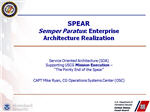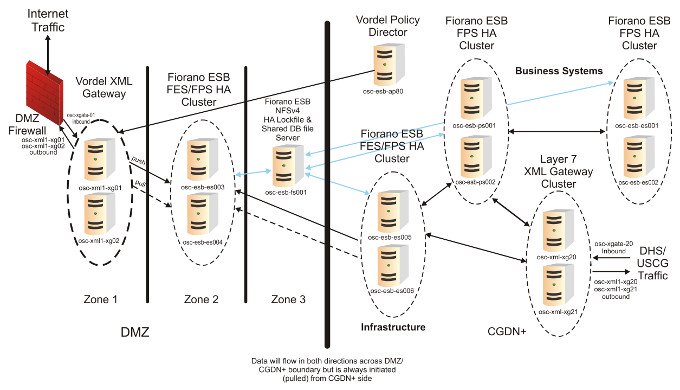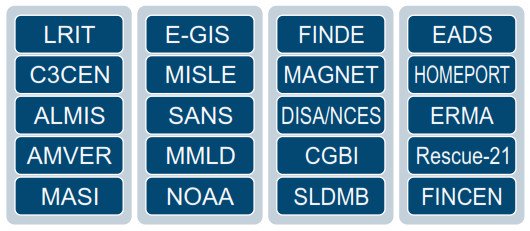Fiorano ESB, Enterprise Service Bus forms backbone of SOA infrastructure at USCG

USCG SPEAR SOA Project Projects & Services Implemented
By Capt. Mike Ryan, Commandant, USCG Operations Center
Following a rigorous 18-month evaluation involving more than a dozen alternatives, Fiorano's SOA Platform was selected to implement the Coast Guard's SOA solutions."
Customer Profile
The United States Coast Guard (USCG) is a military branch of the United States that has a broad and important role in homeland security, law enforcement, search and rescue, marine environmental pollution response, and the maintenance of river, intra coastal and offshore aids to navigation (ATON). It also lays claim to being the United States' oldest continuous seagoing service.
The United States Coast Guard has about 40,150 men and women on active duty. The USCG Operations Center, located in Martinsburg, WV, serves as the premier software development center for the Coast Guard and the Department of Homeland Security.
Business Problem
The Klinger-Cohen Act mandates that federal agencies should operate exactly as efficient and profitable businesses would operate by developing a proficient enterprise architecture. Beyond the federal mandate, an economical infrastructure simply makes good business sense, even for a federal body.
Software developers at the USCG Operations Center, one of the Coast Guard's centers of excellence where it performs software development and systems hosting for the entire Coast Guard and other entities within homeland security, decided to implement a business-driven enterprise architecture to more fully connect information technology systems and business infrastructure.
As acting Chief Technology Officer of the Project under the SETS-II contract, QSS Group's James Jennis was charged with the primary responsibility of implementing enterprise architecture. "The USCG needed an enterprise architecture solution that was document-based and event-driven. We would have to develop a technical implementation of the architecture that custom-fit to Coast Guard doctrine", says James Jennis.
Additionally, the USCG would need to find efficient and reliable enterprise service bus (ESB) technology for its technical implementation of the architecture. This large scale SOA initiative was code named "SPEAR" Semper Paratus: Enterprise Architecture Realization, incorporating the USCG motto.
With an organization as large and prestigious as the USCG, Mr. Jennis and his team would have to evaluate a wide variety of solutions in the market. But was there a solution that was powerful enough to complement the USCG's rigid standards?
Selection Process
Mr. Jennis and his team performed a cut-and-dry evaluation, surveying the market using the Coast Guard's existing architecture and needs as a measuring stick. Eventually, the USCG whittled its search down to 13 different powerful products, one of which was Fiorano's message driven, ESB based SOA solution. USCG performed an initial round of evaluation of vendor glossies, demonstrations and interviews, out of which seven vendors emerged.
Mr. Jennis comments, "At this point in the evaluation process, we put each vendor through a very rigorous proof-of-concept process. We asked each vendor to come in and implement a Coast Guard business solution and graded them based on the success of the solution. Afterwards, we took time to measure the solution against certain performance metrics and assess each vendor for various business factors like how stable they are, how good their support is, etc."
Based on the vendors' scores in 12 different categories, Fiorano SOA was selected at the first phase. The evaluation, however was not over; the next phase would evaluate the top contenders based on long term factors like scalability and reliability. The top contenders would have to take part in a one-year long POC.
"Our evaluation criteria were many", mentions Mr. Jennis. "For one, the solution we would choose would have to comply with Coast Guard architecture. Some of the evaluation categories were: overall cost, installation, maintenance, tool sets, debugging, configuration management, administering applications, feature support, and performance metrics on the proof-of-concept."
SOA for the USCG was defined to mean: Doctrine of event-driven, loosely coupled, asynchronous message based, business services. View USCG "SPEAR" ESB / selection presentation.
Over the year evaluation, Fiorano ESB's reliable backbone messaging, high scalability and ability to handle thousands of messages per second were all factors that helped Fiorano stand out against other solutions.
Solution
Fiorano SOA Platform forms the core platform of the USCG SPEAR architecture. The SPEAR architecture leverages the Fiorano ESB, Enterprise Service Bus as the primary mechanism for data sharing between services and systems.
The enterprise service bus (ESB) is a layer of hardware and software based on reliable asynchronous messaging that provides four main functions to all USCG services and systems:
- Logical routing between services, systems, and other USCG and non-USCG assets.
- Protocol mediation for integration with external and legacy systems.
- Security policy enforcement.
- CGDN+ to DMZ or Internet connections.
All ESB functions are highly customizable and flexible so that they can easily be tailored to fit the particular requirements of most business, mission or system needs.
The ESB implements functionality in units called event processes. These are analogous to operating system processes (programs). Event processes are built using a Graphical User Interface (GUI) tool. The tool is used to compose and configure a collection of small programs into a "flow" and messages are sent along the paths of the flow. The messages used on the ESB are typically formatted as "SPEAR documents". A SPEAR document is an XML document with a structure and format designed specifically for the Coast Guard's Service Oriented Architecture.
USCG Production SOA Architecture Information Flow Diagram

Hosting Services on the ESB
When USCG needs to provide access to resources hosted on other USCG systems, federal agencies, or other organizations outside the Coast Guard, the ESB is the approved, certified and accredited, and architecturally preferred method. There are two main categories of service one might host on the ESB; publishing services and request/response services. A publishing service pushes content out to one or more recipients based on business rules, policies, or events via a SPEAR document. An example of publishing services is publishing Vessel Notices of Arrival.
Benefits
The US Coast Guard's SPEAR implementation recently won the Federal 100 Award for the agility and benefits imparted to USCG operations.
In his interview to Brian Robinson*, Captain Michael Ryan of the OSC of the USCG says "SPEAR" has become pervasive throughout all segments of the Coast Guard's IT community and has helped remove many of the artificial barriers that had developed between various facilities. It's brought the CIOs of the field-level units closer together. On that front, SPEAR has been a huge force multiplier.
It's also had a major effect in other areas. We have a lot of joint ventures with the Acquisition Directorate, for example, and as they go out and interface with industry on new procurements, they are bringing these new principles to the table. [SPEAR has] also opened a lot of doors and created partnerships with other people, from those driving the boats to those running shore-side operations. It's been an initiative that's really transcended all the organizational boundaries.*
Integration of Multiple TechnologiesThe ESB seamlessly integrates multiple technologies including Java, .NET, Oracle forms, Visual Basic etc.
Productivity GainsThe ease of use of the REST-based Fiorano Platform has resulted in significantly compressed development / deployment times and consequent productivity gains at the Coast Guard. 11 Prototype Services were built in just two days for the Marine Information System for Law Enforcement (MISLE) system; SPEAR documents were completed in just a day for Enterprise AIS Data Service (EADS) / Net Centric Enterprise Services (NCES).
The US Coast Guard Long Range Identification and Tracking (LRIT) System, for example, now an SOA-aware service, tracks every vessel in US coastal waters that weighs more than 300 tons through a peer-to-peer, real-time distributed network of over 6,000 ship transponders, powered by the Fiorano Enterprise Service Bus (ESB). These ships must automatically report their position to their Flag Administration every six hours, with ship transponders emitting critical signals every 3 seconds. Integration of LRIT information with that from ship transponders enables the Coast Guard to correlate LRIT data with data from other sources, detect anomalies, and heighten overall Maritime Domain Awareness.
Integrated Business SystemsWith over 80 services built with a small team over the initial implementation period, SPEAR implementations have grown to provide literally scores of enterprise services. Over 50 Business Systems including 12 mission critical systems, both internal and external to the Coast Guard all requiring service enablement are now connected through the ESB. These include: Law Enforcement, Logistics, Maritime Domain Awareness, Financial, Mariner Licensing.

USCG Systems Connected with the Fiorano ESB
Cost Savings
The (SPEAR) service-oriented architecture, will save the Coast Guard millions of dollars; Cost of carrying inventory has been slashed through inventory tracking and deep operational visibility into assets.
Real-time ResponseSPEAR has already improved data sharing and enhanced the service's response to incidents, such as the Deepwater Horizon oil spill.
Prior to its SOA implementation, the US Coast Guard relied on slower manually intensive processes of extracting data from various systems, putting it into spreadsheets and then providing that static content back to somebody who had to manipulate it into something useful. Now, with the SOA framework in place, it is just a matter of hearing from the operational community what information they believe they want and the technical staff can quickly identify sources for that information and establish a new service to allow that dataset to flow across the SPEAR enterprise service bus, Fiorano ESB.
Analyst, ZapThink.
Source: Article: REST-Based SOA: an Iconoclastic Approach by Jason Bloomberg
To find out more about how Fiorano can help you meet your enterprise integration objectives, visit www.fiorano.com or Email us, we will contact you!

 Japan
Japan Germany
Germany

